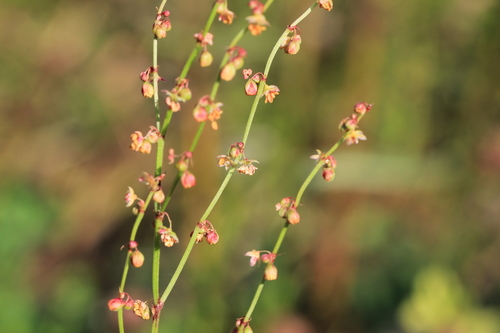Sheep's sorrel
Search
Wikipedia
This article needs additional citations for verification. (May 2014)
|
| Rumex acetosella | |
|---|---|

| |
|
Scientific classification | |
| Kingdom: | Plantae |
| Clade: | Tracheophytes |
| Clade: | Angiosperms |
| Clade: | Eudicots |
| Order: | Caryophyllales |
| Family: | Polygonaceae |
| Genus: | Rumex |
| Species: |
R. acetosella
|
| Binomial name | |
|
Rumex acetosella | |
| Synonyms[1] | |
|
Acetosella vulgaris (W.D.J. Koch) Fourr. | |
Rumex acetosella, commonly known as red sorrel, sheep's sorrel, field sorrel and sour weed, is a species of flowering plant in the buckwheat family Polygonaceae. Native to Eurasia and the British Isles,[2] the plant and its subspecies are common perennial weeds. It has green arrowhead-shaped leaves and red-tinted deeply ridged stems, and it sprouts from an aggressive and spreading rhizome. The flowers emerge from a tall, upright stem. Female flowers are maroon in color.
Description
A perennial herb that has a slender and reddish upright stem that is branched at the top, reaching a height of 50 cm (20 in).[3] The arrow-shaped leaves are small, about 2.4–5 cm (1–2 in) long and .5–2 cm (1⁄4–3⁄4 in) wide, with pointed lobes at the base.[3] It blooms during March to November, when yellowish-green (male) or reddish (female) flowers develop on separate plants at the apex of the stem, which develop into the red fruits (achenes).
Distribution and habitat
Native to Eurasia and the British Isles,[2]Rumex acetosella has been introduced to most of the rest of the Northern Hemisphere. It is commonly found on acidic, sandy soils in heaths and grassland.[2] It is often one of the first species to take hold in disturbed areas, such as abandoned mining sites, especially if the soil is acidic. Livestock will graze on the plant, but it is not very nutritious and is toxic in large amounts because of oxalates. The American copper or small copper butterfly depends on it for food, although its larvae can consume some related plants.
Rumex acetosella is dioecious, with separate male and female plants. It has been found that in early successional habitats, there are relatively more female plants, while in later successional stages, male plants are more common.[4]
Rumex acetosella is widely considered to be a hard-to-control noxious weed due to its spreading rhizome. Blueberry farmers are familiar with the weed because it thrives in the same conditions under which blueberries are cultivated.
Uses
The leaves can be eaten raw or cooked.[5] The oxalic acid they contain lend them a somewhat sour taste.[6] There are several uses of sheep sorrel in the preparation of food including a garnish, a tart flavoring agent, a salad green,[5] and a curdling agent for milk in cheese-making.[citation needed] The leaves have a lemony, tangy or rhubarb-like tart flavor.[5] It is also known as sheep shower in parts of the country.[which?]
Ground-feeding songbirds eat the seeds, and larger animals like rabbits and deer browse the greens.[7]
Effects on animals
Italian agronomist Nicola Onorati (1764-1822) first discovered that rumex acetosella damages the teeth of animals that crop this plant because of oxalic acid.[8][9]
Bibliography
- Andrea Alfonso Vachetta (1877). Elementi di patologia chirurgica degli animali domestici. Milan: Ulrico Hoepli. p. 499.
References
- ^ "Acetosella vulgaris". Germplasm Resources Information Network (GRIN). Agricultural Research Service (ARS), United States Department of Agriculture (USDA). Retrieved 16 December 2017.
- ^ a b c Stace, C. A. (2010). New Flora of the British Isles (Third ed.). Cambridge, U.K.: Cambridge University Press. p. 450. ISBN 9780521707725.
- ^ a b Elias, Thomas S.; Dykeman, Peter A. (2009) [1982]. Edible Wild Plants: A North American Field Guide to Over 200 Natural Foods. New York: Sterling. p. 121. ISBN 978-1-4027-6715-9. OCLC 244766414.
- ^ Houssard, C.; Escarre, J.; Vartanian, N. (1992). "Water stress effects on successional populations of the dioecious herb, Rumex acetosella L". New Phytologist. 120 (4): 551–559. doi:10.1111/j.1469-8137.1992.tb01805.x.
- ^ a b c Nyerges, Christopher (2017). Foraging Washington: Finding, Identifying, and Preparing Edible Wild Foods. Guilford, CT: Falcon Guides. ISBN 978-1-4930-2534-3. OCLC 965922681.
- ^ Fagan, Damian (2019). Wildflowers of Oregon: A Field Guide to Over 400 Wildflowers, Trees, and Shrubs of the Coast, Cascades, and High Desert. Guilford, CT: FalconGuides. p. 218. ISBN 978-1-4930-3633-2. OCLC 1073035766.
- ^ Niering, William A.; Olmstead, Nancy C. (1985) [1979]. The Audubon Society Field Guide to North American Wildflowers, Eastern Region. Knopf. p. 708. ISBN 0-394-50432-1.
- ^ Vachetta, p. 499
- ^ Delle cose rustiche, vol. 3
External links
| Wikimedia Commons has media related to Rumex acetosella. |
- Missouri Plants, More pictures
- Weed of the Week - United States Department of Agriculture Forest Service
